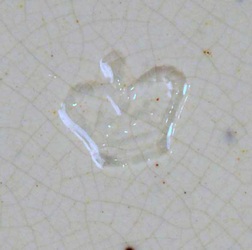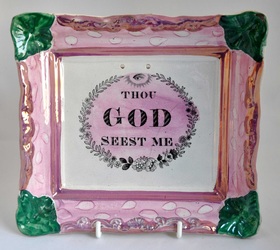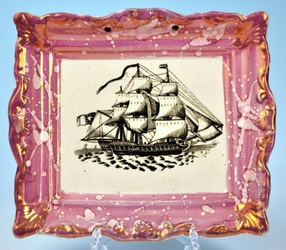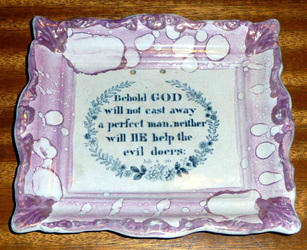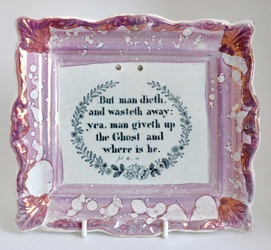|
3/23/2013 0 Comments A feature peculiar to Fell?I got very excited when I saw these plaques at Bellmans Auctioneers recently. They are a true pair in terms of decoration, and have probably been together all their life. One of the plaques has the London impressed mark over an anchor. Looking at the spacing of the holes, it appears to be the 'Prepare' plaque that has the impressed mark. These plaques sometimes appear with an impressed crown mark (see below), which identifies them as Fell & Co. Fell is on Clarice Blakey's list of potteries using the London mark, so it is great to have photos of an example. I have added the Bellmans' plaques to the London impressed mark page. Another feature of the Bellmans' plaques got me thinking. The transfers also appear on plaques with green corners (see below). In a previous blog post I suggested that perhaps the green-cornered plaques were Maling, and that the transfer plates moved to Fell at a later date. I might now have to eat my words. The plaques below all have an unusual feature in common with the Bellmans' plaques. Can you spot it? The feature doesn't appear on any of the plaques I know of with a Maling impressed mark. See below for several examples with impressed Robert Maling and C T Maling marks. In case you haven't already guessed, it is the positioning of the holes for hanging the plaque. As with the rectangular plaques made in Sunderland, the Maling plaques have their holes pierced in the lustre border. See below for a Maling-marked religious example and compare it to the 'Prepares' and 'Thou gods' above. The holes on the Maling plaque are in the lustre border, whereas the green-cornered plaques, as with the Bellmans' plaques, are pierced within the central rectangle of the plaque. So what of other Tyneside users of this plaque form? Below are two marked B & Co plaques, for Burn & Co of the Stepney Bank Pottery. As with the Maling plaques, they are pierced through the lustre border. So does this prove that the green-cornered plaques above are all Fell? You'll notice that one of them has very similar decoration to the plaque on the left below. I think there are two possible explanations for this. Firstly, we know that B & Co emulated Fell and even copied their printed mark (see my previous post). So should we really be surprised if they copied Fell's green decoration? Secondly, it's possible that B & Co supplied Fell with earthenware plaques (or vice versa) for lustre decoration. Something similar could be said for the lustre decoration over the verse transfer on some of the green-cornered plaques. On the basis of the Mustard collection plaque above, I'd previously assumed this to be a feature peculiar to Maling. However, there's no reason why both Maling and Fell couldn't have decorated plaques that way. I can hear your protests already: there's no reason either why both potteries couldn't have varied the position of their hanging holes. I've been through hundreds of photos, trying to find a Fell example pierced through the lustre border. Take a look at the two ship plaques below. Plaques with this transfer sometimes have the Fell crown impressed mark. However, the right plaque, although pierced through the border, has a different transfer (compare the details below). The left plaque with the holes in the centre rectangle, is decorated very similarly to the Bellmans' plaques above, and is, therefore, the one with the claim to be the Fell version. The only other two examples I have recorded with the crown mark, both have holes in the central rectangle. The only similar example I could find pierced through the lustre border, is that on the right below. I'm still not 100% convinced it has the same transfer as the plaque beside it. So this Tyneside series of common verse transfers appears on plaques with a feature apparently peculiar to one pottery. It's not a decorative innovation that other potteries would likely copy. The guy who did the piercing simply preferred his holes lower down, and was damned if he was going to put them anywhere else. As some of these plaques have the Fell crown impress, it seems fairly safe to attribute the others (with the same transfers and the same lower holes) to Fell also.
So my hypothesis is... - Both Burn & Co and Fell produced plaques with green corners/borders (perhaps Maling too) - Both Maling and Fell produced plaques with lustre over the central transfer - Only Fell produced plaques with hanging holes through the central rectangle As always, I'd be very happy to hear from anyone who can add anything to this.
0 Comments
Leave a Reply. |
AuthorStephen Smith lives in London, and is always happy to hear from other collectors. If you have an interesting collection of plaques, and are based in the UK, he will photograph them for you. Free advice given regarding selling and dispersal of a collection, or to those wishing to start one. Just get in touch... Archives
February 2022
AcknowledgementsThis website is indebted to collectors, dealers and enthusiasts who have shared their knowledge or photos. In particular: Ian Holmes, Stephen Duckworth, Dick Henrywood, Norman Lowe, Keith Lovell, Donald H Ryan, Harold Crowder, Jack and Joyce Cockerill, Myrna Schkolne, Elinor Penna, Ian Sharp, Shauna Gregg at the Sunderland Museum, Keith Bell, Martyn Edgell, and Liz Denton.
|





